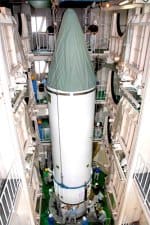A satellite designed to collect vital information about the Sun's magnetic field successfully took off from Japan's Uchinoura Space Centre early on Saturday local time. The Solar-B mission will attempt to understand how the field triggers solar flares and coronal mass ejections, which can cause communications blackouts on Earth. Data from the mission could even be used to predict when these massive explosions occur.

Solar flares are believed to occur when magnetic fields generated deep within the Sun become entangled and then break apart. This process releases huge amounts of radiation and charged particles, which can travel in the solar wind and reach the Earth in as little as 30 minutes. They are followed a few days later by vast quantities of high-energy particles from coronal mass ejections – explosions that occur on the surface of the Sun and are triggered by the solar flares themselves.
Solar flares and coronal mass ejections are dangerous because the particles they release can alter the properties of the Earth’s ionosphere, disrupting short-wave radio signals that are normally reflected back to earth from this region. X-rays from solar flares can also increase the drag on low-orbiting satellites and slow them down. Worst of all, coronal mass ejections can accelerate particles in the Earth’s magnetosphere, setting up strong electric currents, which can zap electronic devices on satellites and damage power supplies on the Earth’s surface.
Solar-B is led by Japan’s space agency (JAXA), with additional support from NASA, the UK’s Particle Phyiscs and Astronomy Research Council, and the European Space Agency. It has three instruments, each designed to measure different aspects of the Sun’s behaviour. The first is a lightweight optical telescope, which can resolve features just 150 km across and can measure the Sun’s magnetic field in 3D. The second instrument is an ultraviolet spectrometer that will take images of the corona – the luminous plasma “atmosphere” of the Sun – helping scientists to relate the movement of hot gases to the underlying magnetic fields. The craft also contains an X-ray telescope, which will observe and record the emissions of the corona at different temperatures.
Data from the $210m craft will start arriving relatively quickly, with “first light” from the various pieces of equipment arriving between 33 and 37 days after launch. The “initial science phase”, when the first important data will be received, will take place some 50–60 days after launch. The satellite itself will circle the Earth in a special “polar orbit” that will let it take data for nine months every year over a planned mission lifetime of three years.
“Solar flares are fast and furious – they can cause communication black-outs at Earth within 30 minutes of a flare erupting on the Sun’s surface,” says Louise Harra, the UK Solar-B scientist based from the Mullard Space Science Laboratory at University College London. “It’s imperative that we understand what triggers these events with the aim of being able to predict them with greater accuracy.”





